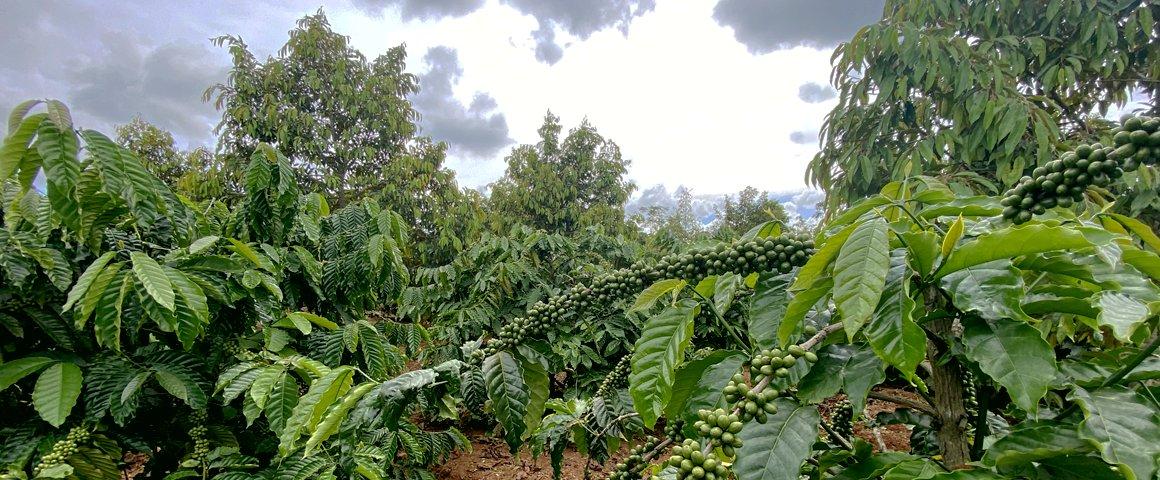Results & impact 10 October 2025
- Home
- Press area
- Press releases
- Vietnam: coffee growers are diversifying
In Vietnam, coffee growers are branching out into pepper and fruit production

Mixed coffee and durian plot © C. Rigal, CIRAD
Like all agricultural products traded on global markets, coffee is subject to substantial price variations. Vietnamese producers are known for their responsiveness and ability to adapt to price fluctuations. For instance, during the coffee price crisis of the early 2000s, many coffee growers began to diversify their farms by planting pepper plants between coffee rows. More recently, with the surge in the price of fruits such as durians and macadamia nuts, fruit tree numbers are increasing. "While coffee growing initially relied on monoculture systems alone, we estimate that some 50% of the area under coffee is now also planted with a mix of other crops, primarily pepper and/or fruit crops", says Clément Rigal, a CIRAD agronomist specializing in coffee.
Highly intensive practices that consume large volumes of inputs and water
Clément Rigal and his Vietnamese counterparts from ICRAF (World Agroforestry Center) and WASI (Western Highlands Agriculture & Forestry Science Institute) conducted a survey, published in the journal Ecological Economics, analysing the changes in coffee and pepper cropping practices in Vietnam over the past decade in three of the main producing provinces in the Central Highlands. First of all, the survey revealed how intensive farming practices in this part of Vietnam are. "The amounts of inputs used, not just synthetic fertilizers but also pesticides and irrigation water, are much higher than recommended. Yields are therefore amongst the highest in the world, but at the expense of a financial burden for farmers and degraded soils and ecosystems", Clément Rigal explains. Reducing input use is therefore clearly a priority if coffee and pepper growing in the region is to become sustainable. To this end, trials are under way with a view to rationalizing synthetic fertilizer use and restoring soil fertility, as part of a range of projects including V-Scope, Bolero and ECOFFEE.
Increasingly dense, diversified plots
Moreover, the study also revealed that producers are densifying their plots by diversifying what they grow in them. Each new wave of planting is in addition to what was there before. The most diverse systems, combining coffee, pepper and fruit trees, are now also the densest and most productive, with as yet limited competition between crops. "A cost-gross product analysis showed that these systems are the most profitable and resilient as regards price fluctuations", Clément Rigal points out. "In the Central Highlands of Vietnam, farmers often tailor their choice of crops to market fluctuations. This is not a recent phenomenon. For instance, many farmers abandoned coffee in favour of pepper when pepper prices rose. However, this drove many farmers bankrupt, since they jumped on the bandwagon without thinking about supply and demand. As a result, crop diversification is a better option, as it guarantees stable incomes and also fosters sustainable, long-term agricultural development for the future", Tuan Duong from ICRAF in Vietnam adds. The first additional studies of water use have also shown that diversified systems are more resilient than monocultures in the event of drought.
Coffee and pepper growing will no doubt continue to evolve in the coming years. The fruit trees planted on a large scale will soon be fully productive. The price of avocados is already falling, and that of durians could well follow suit. "It is fair to assume that some of those fruit trees will be replaced by a new wave of planting, further increasing the diversity of cultivated plots", says Clément Rigal.
Reference
Rigal Clément, Duong Tuan, Vo Cuong, Bon Le Van, Hoang quôc Trung, Chau Thi Minh Long, Transitioning from Monoculture to Mixed Cropping Systems: The Case of Coffee, Pepper, and Fruit Trees in Vietnam, Ecological Economics, Volume 214, 2023.



























